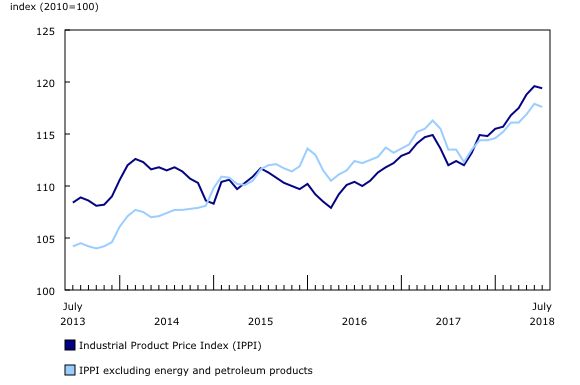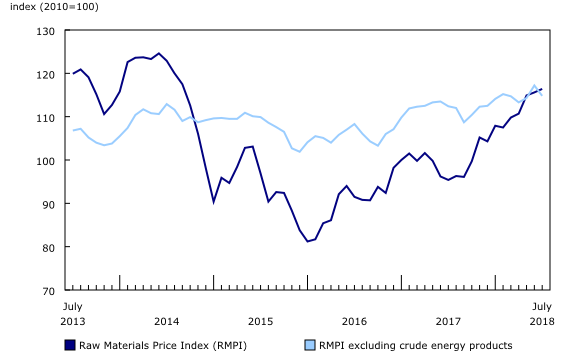Industrial product and raw materials price indexes, July 2018
Archived Content
Information identified as archived is provided for reference, research or recordkeeping purposes. It is not subject to the Government of Canada Web Standards and has not been altered or updated since it was archived. Please "contact us" to request a format other than those available.
Released: 2018-08-31
Prices for products sold by Canadian manufacturers, as measured by the Industrial Product Price Index (IPPI), declined 0.2% in July, led by lower prices for primary non-ferrous metal products. Prices for raw materials purchased by Canadian manufacturers, as measured by the Raw Materials Price Index (RMPI), rose 0.7%, primarily on higher prices for crude energy products.
Industrial Product Price Index, monthly change
The IPPI was down 0.2% in July, following a 0.7% increase in June. July marked the first decline in the IPPI in 2018. Of the 21 major commodity groups, 7 were down, 10 were up and 4 were unchanged.
Primary non-ferrous metal products (-3.3%), which posted their largest decline since July 2017, were the main source of the decline in the IPPI. Lower prices for unwrought precious metals and precious metal alloys (-3.9%) and unwrought copper and copper alloys (-10.1%) pulled this commodity group downward. To a lesser extent, prices of other unwrought non-ferrous metals and non-ferrous metal alloys (-2.9%) and unwrought aluminum and aluminum alloys (-3.1%) also contributed to the decline of primary non-ferrous metal products.
To a lesser extent, chemicals and chemical products (-0.5%) and fruit, vegetables, feed and other food products (-0.5%) also contributed to the decrease in the IPPI.
The decline in the chemicals and chemical products group was largely due to lower prices for other basic inorganic chemicals (-1.6%), ammonia and chemical fertilizers (-2.6%) and petrochemicals (-0.9%).
Lower prices for animal feed (-2.5%), specifically chicken and turkey feed (-5.1%), were mainly responsible for the decrease in fruit, vegetables, feed and other food products.
Conversely, prices for meat, fish and dairy products rose 0.9% compared with June, mainly attributable to higher prices for fresh and frozen pork (+2.2%), processed meat products, other meats and animal by-products (+1.6%) and fresh and frozen beef and veal (+1.0%).
Motorized and recreational vehicles (+0.4%) rose for a third consecutive month in July, mainly due to higher prices for passenger cars and light trucks (+0.7%).
Some IPPI prices are reported in US dollars and converted to Canadian dollars using the average monthly exchange rate. Consequently, any change in the value of the Canadian dollar relative to the US dollar will affect the level of the index. From June to July, the Canadian dollar was unchanged relative to the US dollar.
Industrial Product Price Index, 12-month change
The IPPI rose 6.6% in July compared with the same month a year earlier, continuing the upward trend that began in October 2016. Of the 21 main commodity groups, only the meat, fish and dairy products group was down year over year.
Prices for energy and petroleum products (+27.8%), particularly motor gasoline (+26.7%), light fuel oils (+36.2%) and diesel fuel (+36.1%), were mostly responsible the year-over-year increase in the IPPI in July. The IPPI excluding energy and petroleum products rose 3.6%.
Pulp and paper products (+17.3%) also rose compared with July 2017. Higher prices for wood pulp (+27.0%) and newsprint (+34.1%) were primarily responsible for this increase.
Year over year, primary non-ferrous metal products rose 7.8%, on the strength of higher prices for other unwrought non-ferrous metals and non-ferrous metal alloys (+16.1%) and unwrought aluminum and aluminum alloys (+13.0%). Prices for basic and semi-finished products of aluminum and aluminum alloys (+14.8%) and unwrought copper and copper alloys (+8.2%) also contributed significantly to the increase in this group.
Chemicals and chemical products (+4.1%) and motorized and recreational vehicles (+1.5%) were among the other commodity groups that rose over July 2017.
Compared with the same month last year, prices for meat, fish and dairy products fell 2.1%, mostly due to lower prices for fresh and frozen pork (-8.6%).
Raw Materials Price Index, monthly change
The RMPI rose for the fifth consecutive month, up 0.7% in July following a 0.6% increase in June. Of the six major commodity groups, three were up, two were down and one was unchanged.
The increase in the RMPI in July was mainly due to higher prices for crude energy products (+3.8%), particularly conventional crude oil (+3.8%), following a 1.5% decline the previous month. The RMPI excluding crude energy products fell 2.0%.
To a lesser extent, animals and animal products (+0.6%) also contributed to the increase in the RMPI. Higher prices for fish, shellfish and other fishery products (+3.6%), live poultry (+2.0%) and cattle and calves (+0.8%) were mainly responsible for this gain.
The increase in the RMPI was mostly offset by lower prices for metal ores, concentrates and scrap, which fell 5.1% after increasing 3.6% in June. Prices for crop products (-1.4%) were also down in July.
Raw Materials Price Index, 12-month change
The RMPI was up 22.0% over the 12-month period ending in July, following a 20.2% increase in June. Year over year, the RMPI has risen every month since October 2016.
The growth in the RMPI compared with July 2017 was mainly due to higher prices for crude energy products (+53.2%), which posted their largest year-over-year gain since February 2017. The increase in this commodity group was mostly attributable to higher prices for conventional crude oil (+55.3%). The RMPI excluding crude energy products rose 2.1%.
Compared with July 2017, metal ores, concentrates and scrap (+7.7%) also put upward pressure on the RMPI. Prices for waste and scrap of metal (+18.4%) contributed the most to this increase.
Year over year, prices for animals and animal products (-3.5%) were down for a fifth consecutive month in July, mainly due to low prices for hogs (-10.9%) and cattle and calves (-4.7%).
Note to readers
The Industrial Product Price Index (IPPI) and Raw Materials Price Index (RMPI) are available at the Canada level only. Selected commodity groups within the IPPI are also available by region.
With each release, data for the previous six months may have been revised. The indexes are not seasonally adjusted.
The Industrial Product Price Index reflects the prices that producers in Canada receive as the goods leave the plant gate. It does not reflect what the consumer pays. Unlike the Consumer Price Index, the IPPI excludes indirect taxes and all the costs that occur between the time a good leaves the plant and the time the final user takes possession of it, including transportation, wholesale and retail costs.
Canadian producers export many goods. They often indicate their prices in foreign currencies, especially in US dollars, which are then converted into Canadian dollars. In particular, this is the case for motor vehicles, pulp, paper and wood products. Therefore, a rise or fall in the value of the Canadian dollar against its US counterpart affects the IPPI. However, the conversion into Canadian dollars only reflects how respondents provide their prices. This is not a measure that takes the full effect of exchange rates into account.
The conversion of prices received in US dollars is based on the average monthly exchange rate established by the Bank of Canada and available in table 33-10-0163-01 (series v111666275). Monthly and annual variations in the exchange rate, as described in the release, are calculated according to the indirect quotation of the exchange rate (for example, CAN$1 = US$X).
The Raw Materials Price Index reflects the prices paid by Canadian manufacturers for key raw materials. Many of those prices are set on the world market. However, as few prices are denominated in foreign currencies, their conversion into Canadian dollars has only a minor effect on the calculation of the RMPI.
A Historical Timeline of Canadian Producer Price Statistics
The publication "A Historical Timeline of Canadian Producer Price Statistics," which is part of the Prices Analytical Series (62F0014M), was created to showcase the key milestones in the history of Canadian producer price statistics. This historical timeline contains answers to questions such as: Who collected Canada's first statistics? What do Canadian producer price indexes measure?
Infographic: Producer Price Indexes at a Glance
The infographic "Producer Price Indexes at a Glance," which is part of Statistics Canada — Infographics (11-627-M), demonstrates how producer price indexes for goods and services are calculated and why they are important for the Canadian economy.
Real-time table
Real-time table 18-10-0248-01 will be updated on September 10.
Next release
The industrial product and raw materials price indexes for August will be released on September 28.
Contact information
For more information, or to enquire about the concepts, methods or data quality of this release, contact us (toll-free 1-800-263-1136; 514-283-8300; STATCAN.infostats-infostats.STATCAN@canada.ca) or Media Relations (613-951-4636; STATCAN.mediahotline-ligneinfomedias.STATCAN@canada.ca).
- Date modified:





